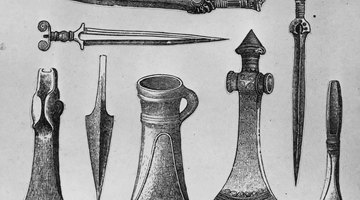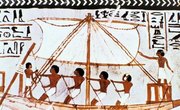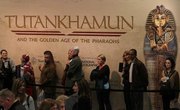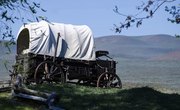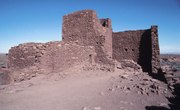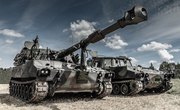Between the Stone Age and the Iron Age, the discovery of how to make bronze -- from copper and tin -- revolutionized tool and weapon-making. Advances in agriculture allowed settlements to support workers such as miners and blacksmiths, who recovered the ore and forged, smelted, cast and burnished bronze goods. Metal objects made of bronze were used as domestic tools and for war. The only military advantage more powerful than bronze weapons was an army outfitted with bronze, riding into battle on horseback.
Artifacts of an Age
The Bronze Age developed in different cultures in different millennia: in Greece, Turkey and Crete around 3000 BC; in China, Egypt, the Middle East, and Europe about a thousand years later, around 1900 BC. There was no Bronze Age in the Americas and Oceania -- Stone Age tools and weapons were replaced there when invaders introduced iron. But the use of bronze represented a significant change to a culture. Unlike stone implements, the copper-tin alloy could be melted and cast in molds to produce multiple versions of the same tools. The metal didn't chip, crack or break and could be bent, incised and shaped into more efficient forms. Bronze tools and weapons, often interchangeable, included axes, swords, knives, daggers, spearheads, razors, gouges, helmets, cauldrons, buckets, horns and many other useful objects.
Daggers, Swords and Axes
Stone tools and weapons are unyielding and can shatter. Metal permitted longer, more resilient blades, so the bronze sword evolved from the stone dagger. Bronze's composition of 90 percent copper and 10 percent tin was really strong and could be polished into a golden sheen that resembled an artifact of real gold. A fine sword was an article of prestige as much as utility. Axes, or celts, made of bronze were used for such practical pursuits as chopping down trees and trimming logs into lumber. They were also very effective when applied to the head of an enemy. Metalworkers and blacksmiths invented ways to hammer the edges of an ax to make curved flanges, hollowing out sockets for a shaft to fit into securely. A bronze loop for lashing the ax to the shaft improved not only weapon use but the utility of the ax as a spade, a crowbar and a pickaxe.
Hoards, Tombs and Bogs
In Ireland, caches of bronze objects have been unearthed in "hoards," the funerary stockpiling of grave goods that accompanied a great warrior, ruler or prominent person into final repose. More than 200 hoards filled with metal goods have been excavated from barrows and fields. Late Bronze Age hoards in Britain, Scotland and Ireland, containing the burial artifacts of a single warrior, all hold at least one but often two or more fine bronze swords. More well-preserved artifacts have been found in peat bogs, where the lack of oxygen prevents or slows deterioration. In a County Antrim bog, a votive, or ritual hoard of bronze items was so well preserved that the wool clothing with horsehair tassels it was wrapped in was also intact when uncovered.
China's Buried Treasure
China's Bronze Age started around 1700 BC, during the Shang dynasty, and the earliest use of the metal was for great ritual cauldrons and ornately decorated vessels for ceremonies and ancestor worship. But the lure of military might was irresistible and, at the death of Emperor Qin Shi Huang in 210 BC, the more than 7,000 life-size terracotta warriors buried with him in Xi'an, were each outfitted with full bronze battle gear. Weapons included tens of thousands of bronze arrowheads, axes, spears, crossbows with bronze triggers, lances and swords. China's bronze ritual bowls and weapons show advanced degrees of artistry. The great cauldrons are individually carved and incised; the weapons are mass-produced in standardized batches, hand-crafted to precise specification by groups of artisanal shops or factories.
Related Articles
References
- National Museum of Ireland: Bronze Age
- Columbia University Asia for Educators: The Great Bronze Age of China
- BBC: Bronze Age Britain
- Metropolitan Museum of Art: Irish Bronze Age Weapons
- Encyclopedia Britannica Kids: Bronze Age
- The Washington Post: Chinese Terra Cotta Warriors Had Real, and Very Carefully Made, Weapons
Writer Bio
Benna Crawford has been a journalist and New York-based writer since 1997. Her work has appeared in USA Today, the San Francisco Chronicle, The New York Times, and in professional journals and trade publications. Crawford has a degree in theater, is a certified Prana Yoga instructor, and writes about fitness, performing and decorative arts, culture, sports, business and education .

